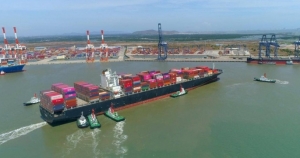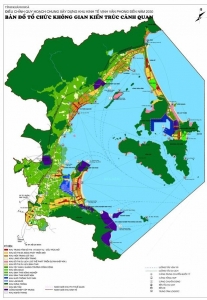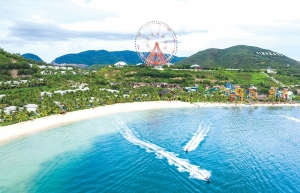Crucial maritime initiatives must be carefully crafted
The government has released its sustainable marine strategy for the next decade, what are its key points?
 |
| Deputy Minister of Natural Resources and Environment, Le Minh Ngan |
The strategy is formulated in accordance with the law on natural resources and environment of sea and islands, as well as the Party’s major guidelines on the sustainable development of Vietnam’s marine economy.
Our desire by 2050 is that sea and island resources are properly exploited and effectively used to turn Vietnam into a strong maritime nation. The strategy reaffirms the government’s commitment to green growth, biodiversity conservation, marine environment protection, and a society in harmony with nature.
Thus, the strategy aims to ensure the efficient and equitable exploitation and use of natural resources in Vietnam’s coastal areas, islands, archipelagos, seas, and airspace, based on a harmonious combination of socioeconomic interests, environmental protection, and national defence.
The strategy sets out that all hazardous waste and domestic solid waste will be collected and treated under national environmental standards. Economic and industrial zones, and coastal urban areas are planned in the direction of sustainability, ecology, smartness, and adaptation to climate change, while meeting standards and regulations on the environment.
Furthermore, it is expected to better manage and protect marine, coastal, and island ecosystems, increase the area of marine reserves, and increase the total area of marine and coastal protected areas to at least 6 per cent of the country’s natural marine area.
It will also protect breeding areas, migration routes, and habitats of aquatic animal species, biosphere reserves, and restore coastal mangrove areas to the level of the year 2000.
Another goal is to survey and map at least half of Vietnam’s maritime zones in terms of marine resources and ecology on a 1:500.000 scale.
What work will the Ministry of Natural Resources and Environment focus on to work towards these set strategic goals?
From now until 2030, it plans to focus on six groups of work. First is to prioritise the arrangement of marine space to develop marine economic fields; as well as zoning the use of marine space to overcome conflicts and overlapping interests in exploitation and use of resources, paying special attention to people’s livelihoods and environmental protection requirements.
Second is to carry out an investigation, classification, monitoring, and assessment of pollution types, status, and sources; as well as assessment of environmental load capacity, and level of risks of marine environmental pollution for marine economic development.
Thirdly, it is necessary to protect and maintain the existing system of marine protected areas, study new marine protected areas, and step up the investigation, assessment and identification of vulnerable and endangered species of endemic marine species to come up with plans and solutions to protect and conserve them.
Fourth is to strengthen the capacity of monitoring, forecasting, and warning and have an early warning system at sea and coastal areas to protectively respond to natural disasters. We must implement solutions to restore marine and coastal ecosystems, such as mangrove restoration, to minimise damage caused by sea level rises, saltwater intrusion, and other related impacts.
Fifthly, we must implement the key initiative for basic investigation of marine resources and the environment as well as prioritising new resource discovery projects, biodiversity conservation projects, marine cultural heritage conservation projects, and periodic investigation projects for different types of marine resources.
Sixthly, it is necessary to promote research, transfer, and application of modern, environmentally friendly technologies in the exploitation and use of resources and develop tools and equipment to monitor and control marine environmental pollution and promote international cooperation in controlling transboundary pollution sources such as marine plastic waste, and oil spill response.
How will improvements in the legal system aid in marine and island environment protection?
The improvement of the legal system on environmental protection of the sea and islands is one of the groups of solutions proposed in the strategy.
Going forward, we think it is necessary to study and develop a Law on the Management and Use of Marine Areas. This will regulate activities in the right of organisations and individuals to use certain sea areas to exploit and use marine resources and create a legal corridor to apply economic tools in the management of marine resources and environment, such as fees as well as formulating policies to encourage economic and social development, combining defence and security protection on islands, as well as social policies.
 | Vietnam and ASEAN seek closer cooperation in maritime transport Representatives from the 10 ASEAN member countries are gathering at the 42nd meeting of the bloc's Maritime Transport Working Group (MTWG) hosted by Vietnam to discuss new innitiatives for closer cooperation. |
 | Van Phong accentuates raising maritime economy On April 13, Deputy Prime Minister Le Van Thanh signed Decision No.451/QD-TTg approving the adjustment of planning for Van Phong Economic Zone in the central province of Khanh Hoa. |
 | Maritime tourism focus for Khanh Hoa Khanh Hoa province is making efforts to accomplish its vision of being a worldwide hub for maritime tourism and services. |
What the stars mean:
★ Poor ★ ★ Promising ★★★ Good ★★★★ Very good ★★★★★ Exceptional
 Tag:
Tag:
Related Contents
Latest News
More News
- Heavy industries set for pilot greenhouse gas quotas (December 25, 2025 | 10:00)
- Swedfund invests in MSME growth and climate action in Vietnam (December 19, 2025 | 11:42)
- GreenYellow brings solar energy to light up remote schools in Tuyen Quang province (December 19, 2025 | 08:00)
- Charge+, Grab partner to develop EV charging network in Vietnam (December 18, 2025 | 17:11)
- Linking sci-tech and innovation to Vietnam’s net-zero future (December 18, 2025 | 14:31)
- Driving double-digit growth through green and circular transformation in Vietnam (December 17, 2025 | 09:00)
- Standard Chartered and ACCA deepen collaboration to develop Vietnam’s talent for a sustainable future (December 15, 2025 | 18:18)
- Schaeffler reports strong early output from Dong Nai solar project (December 12, 2025 | 15:16)
- Forestry conference highlights biodiversity and sustainability goals (December 09, 2025 | 13:35)
- Home Credit honoured among top 10 sustainable companies in trade and services (December 09, 2025 | 12:18)






















 Mobile Version
Mobile Version